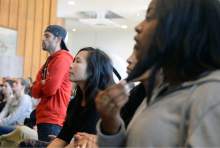This is an archived article that was published on sltrib.com in 2017, and information in the article may be outdated. It is provided only for personal research purposes and may not be reprinted.
New census estimates show that Utah's minority populations continue to be younger and grow faster than whites — signaling a state shift to what one demographer calls "a mixed-heritage, multicultural tapestry of people and cultures."
"That's the new Utah," not the old one that was nearly homogeneous and white, said Pam Perlich, director of demographic research at the University of Utah's Kem C. Gardner Policy Institute.
For example, new estimates released Thursday show that minorities now account for 21 percent of Utah's population — one of every five residents, as of July 1, 2016. That is up from 19 percent in the 2010 Census.
Since 2010, Utah's minority population grew by 20.3 percent, while the white population increased by a much smaller 8 percent.
The Asian population swelled in that time by nearly 34 percent (adding 18,446 people); the number of residents with mixed heritage jumped by 30.8 percent (adding 14,361); the black population rose by 23.2 percent (6,107 people); the amount of Pacific Islanders went up 20.2 percent (4,887 people); Hispanics' count climbed by 17.3 percent (62,100 people); and the number of American Indians increased by 11 percent (2,992 people).
In short, every minority group saw faster growth rates than whites during this decade.
Perlich said that will likely continue because Utah's older generations — which are losing bigger numbers to death — are mostly white. Younger generations are more diverse.
For example, 35 percent of minorities are under age 18, while 29 percent of whites are. Among people with mixed heritage, a majority are under 18 — 52.1 percent. Perlich said most of them are children of a parent who came to the state in a big wave of immigration during the 1990s and 2000s before the Great Recession.
"It's evidence that great demographic transformation of Utah continues to unfold year by year…. If we do the math, we can see how Utah will continue to become more diverse," Perlich said. "These trends are cumulative, ongoing and irreversible."
She notes that while Hispanics saw the largest numeric growth among minorities, virtually none of the increase recently is from immigration. Nearly all of it is from births.
"Our major source region for international immigrants to Utah is now Asia," mostly from China and India, Perlich said. She said most of these recent residents are young adults attracted to high-tech jobs and research universities.
"The census tracts with the highest concentrations of Asians in Salt Lake City are at the University [of Utah]," she said.
"We are in a global competition for talent. Utah is globally connected, and our urban area is emerging as a global city. We are also headquarters to a growing global religion. And our engine of economic growth continues to attract young adults for economic and educational opportunities."
Diversity in Utah may be even greater than numbers seem to indicate, Perlich added, because even whites come from many countries and cultures. She said a university survey of schoolchildren here found they report speaking 129 languages at home.
Nearly half of all Utah's minorities live in Salt Lake County, 315,856 people. They account for 28.2 percent of the county's population. Utah County had 101,639 minorities, followed by 58,227 in Weber County and 54,066 in Davis County.
San Juan County — home to part of the large Navajo reservation — had the highest minority share of its population, 56.5 percent. Salt Lake County was No. 2, followed by Weber County (23.5 percent), Uintah County (18.3 percent) and Grand County (17.5 percent).
The new estimates show that Utah is also changing in another way: It's growing older.
It still has the youngest median age among the states, age 30.8, but that is up by 3.7 years since 2000. This uptick comes as Utah traditionally has had the nation's highest birthrate, but it has been dropping here and nationally.
"Every state saw an increase or had the same median age as a year earlier," said Census Bureau demographer Amel Toukabri.
Nationally, all racial groups saw an increase from having more births than deaths "with one exception. The non-Hispanic white alone group experienced a natural decrease of 163,300 people nationally. That's more deaths than births," said Census Bureau demographer Molly Cromwell.
This trend tracks the large baby boom generation seeing more deaths as its members started turning 65 in 2011.
Whites and all groups in Utah continue to grow. Perlich said, "Our age structure is still young enough and the fertility rate high enough that natural increase [births minus deaths] remains positive. Our projections indicate that this should continue to be the case in Utah for the foreseeable future."



